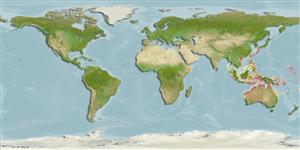Common names from other countries
>
Siluriformes (Catfishes) >
Plotosidae (Eeltail catfishes)
Etymology: Paraplotosus: Greek, para = in the side of + Greek, plotos = swimming (Ref. 45335); butleri: Named in honor of W. 'Harry' Butler, who assisted in with the collection of many of the paratypes (Ref. 31103).
Environment: milieu / climate zone / depth range / distribution range
Écologie
marin récifal; profondeur 0 - 5 m (Ref. 31103). Tropical
Indo-West Pacific: northern Australia.
Taille / Poids / Âge
Maturity: Lm ? range ? - ? cm
Max length : 32.5 cm SL mâle / non sexé; (Ref. 31103)
Description synthétique
Morphologie | Morphométrie
Épines dorsales (Total): 1; Rayons mous dorsaux (Total): 115-130; Épines anales 0; Rayons mous anaux: 87 - 102. Differs from Paraplotosus albilabris and P. muelleri in having a tall, sail-like first dorsal fin and extremely long nasal barbels, which extend posteriorly to the basal third of the pectoral fin or beyond (Ref. 31103). Small juveniles have a unique coloration consisting of a black head and body with a broad white to yellow margin on the first dorsal fin and continuous dorsal-caudal-anal fin (Ref. 31103). Adults entirely black (Ref. 31103).
Restricted to coastal reefs (Ref. 31103). Secretive, found in reef holes or under large rocks (Ref. 31103). Presumably nocturnal (Ref. 31103). Feeds on gastropod mollusks and crustaceans (Ref. 31103).
Life cycle and mating behavior
Maturité | Reproduction | Frai | Œufs | Fécondité | Larves
Allen, G.R., 1998. A review of the marine catfish genus Paraplotosus (Plotosidae) with the description of a new species from north-western Australia. Raf. Bull. Zool. 46(1):123-134. (Ref. 31103)
Statut dans la liste rouge de l'IUCN (Ref. 130435)
CITES (Ref. 128078)
Not Evaluated
Menace pour l'homme
Harmless
Utilisations par l'homme
Plus d'informations
Noms communsSynonymesMétabolismePrédateursÉcotoxicologieReproductionMaturitéFraiFéconditéŒufsDéveloppement de l'œuf
Taille/ÂgeCroissanceLongueur-poidsLongueur-longueurFréquences de longueursMorphométrieMorphologieLarvesDynamique des populations larvairesRecrutementAbondance
RéférencesAquacultureProfil d'aquacultureSouchesGénétiqueElectrophoresesHéritabilitéPathologiesTraitementMass conversion
CollaborateursImagesStamps, Coins Misc.SonsCiguateraVitesseType de nageSurface branchialeOtolithesCerveauxVision
Outils
Articles particuliers
Télécharger en XML
Sources Internet
Estimates based on models
Preferred temperature (Ref.
115969): 24.4 - 29.2, mean 28.3 (based on 1313 cells).
Phylogenetic diversity index (Ref.
82804): PD
50 = 0.6250 [Uniqueness, from 0.5 = low to 2.0 = high].
Bayesian length-weight: a=0.00457 (0.00199 - 0.01049), b=3.07 (2.86 - 3.28), in cm Total Length, based on LWR estimates for this (Sub)family-body shape (Ref.
93245).
Niveau trophique (Ref.
69278): 3.4 ±0.54 se; based on food items.
Résilience (Ref.
120179): Haut, temps minimum de doublement de population inférieur à 15 mois (Preliminary K or Fecundity.).
Fishing Vulnerability (Ref.
59153): Low to moderate vulnerability (30 of 100).
